
End-of-Year Spending Spree Wastes Up to $100 Billion Each Year | September 13, 2021
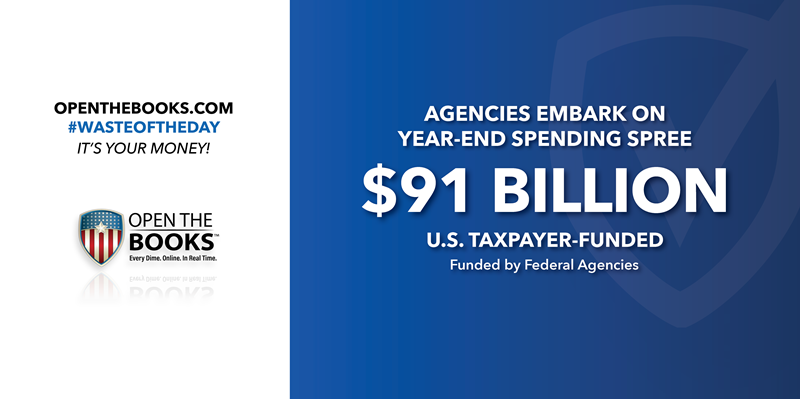
During September 2019, federal agencies spent $91 billion on 642,567 transactions — an average of $3 billion on 21,418 transactions each day. In September 2018, the feds spent $97 billion.
If those figures are shocking, they should be.
Federal agencies worry that if they spend less than their budget allows, Congress may give them less funding next fiscal year.
So, they begin an annual spending spree with a “use-it or lose-it” mentality to spend all their budgeted funds by the end of the fiscal year, Sept. 30.
That led to spending $91 billion in just one month in 2019, with $23.8 billion of that coming in just the final two business days of the fiscal year, according to an oversight report by OpenTheBooks.com.
Monday, Sept. 30, 2019, the last day, broke all records with $12.2 billion in spending. Friday, Sept. 27, was second in line, spending $11.6 billion.
This year-end spending spree went to massive purchases like aircraft ($5.2 billion), gas turbines and jet engines ($4.4 billion), and construction of buildings ($1.4 billion). But it also paid for things like clothes ($328 million), transportation ($254 million) furniture ($458 million), food ($536 million), marketing and public relations ($457 million), batteries ($53 million), books and pamphlets ($23 million), and games, toys, and wheeled goods ($1.1 million).
There must be a better way to spend $91 billion of taxpayer money.
Duplicative Federal Programs Cost U.S. Taxpayers Much More Than $23 Billion a Year
September 14, 2021
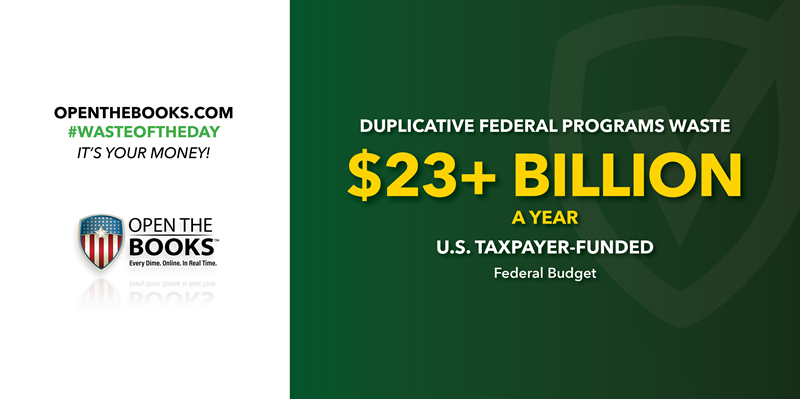
President Donald Trump’s 2021 budget to Congress touted his “pro-growth policies” as being responsible for “one of the strongest economies in American history” but it also noted how much of federal spending is wasteful.
“A bloated federal government, with duplicative programs and wasteful spending, remains a critical threat to America’s future,” according to the budget section “Stopping Wasteful and Unnecessary Spending.”
To eliminate waste, the budget proposed eliminating duplicative programs and gave 10 examples – including the U.S. Department of Agriculture making payments to farmers for crop loss under both a disaster assistance program and the crop insurance program, which pays some farmers more than 100% of their loss.
The president’s budget suggested saving taxpayers $4.7 billion by consolidating 29 overlapping elementary and secondary programs into a new block grant to states and school districts.
It would have consolidated the 40 programs across 15 federal agencies engaged in "workforce development" that spend $19 billion per year.
It also planned to remove funding for 14 health professions training programs in the Department of Health and Human Services, as there are 91 healthcare training programs in the departments of Defense, Education, Health and Human Services, and Veterans Affairs.
The budget points out that there are numerous federal programs that duplicate those of state and local governments or the private sector.
It suggests eliminating the USDA’s Rural Business Service Programs, which have given more than $1 billion in the last decade to “already successful businesses that could qualify for private sector capital.”
These examples are only the tip of the waste iceberg that, if eliminated, would save taxpayers billions of dollars.
Reese Witherspoon, Jason Bateman Films Among Those Getting $1.6B from Taxpayers | September 15, 2021
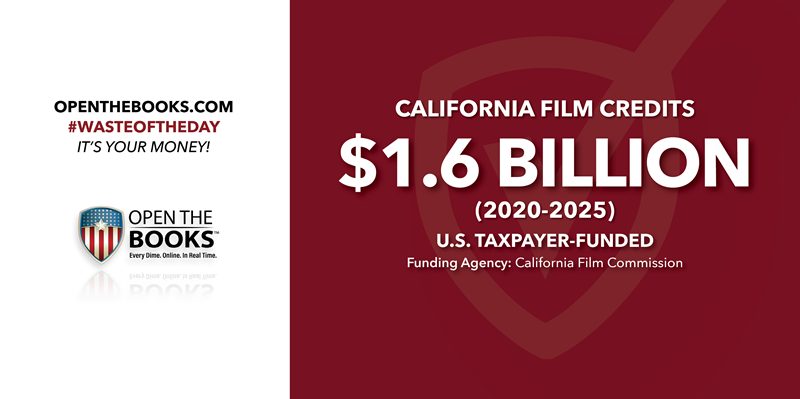
Every year, the California Film Commission gives $330 million in tax credits to movie and TV programs being filmed in the Golden State.
The film commission’s Film & Television Tax Credit Program 3.0 runs for five years, ending on June 30, 2025, totaling $1.6 billion in tax credits, Variety reported.
The latest round of $86.9 million goes to recipients including the Coen brothers, Steven Soderbergh, Reese Witherspoon, and Jason Bateman.
“Here Comes the Flood,” directed by Bateman, will get a $13.8 million subsidy and air on Netflix, as will “Me Time,” a comedy starring Kevin Hart that received a $7.6 million subsidy, Variety reported. Universal’s “Scarface” will be directed by Luca Guadagnino with a script from Joel and Ethan Coen and received a $9.8 million state subsidy.
An untitled live-action project from Universal got $12.2 million, and its film “Ashley’s War” got $10.7 million. Witherspoon is producing “Ashley’s War,” adapted from a book about women soldiers in Afghanistan.
Soderbergh’s “Kimi” is also getting $3.1 million, and “Flamin’ Hot,” from director Eva Longoria about the creator of Flamin’ Hot Cheetos, collected $4.4 million, according to Variety.
Commission Executive Director Colleen Bell told Variety that 61 projects applied for the tax credit, which shows a strong interest in filming despite the pandemic.
“The industry is bullish on California,” she said. “This is a time where people would like to stay close to home.”
It’s hard not to wonder whether all the people watching these movies at home know $1.6 billion of taxpayer dollars is being given to them.
$2.5 Million In Taxpayer Funds Used to Determine Why Rats, Monkeys Clench Their Jaws | September 16, 2021
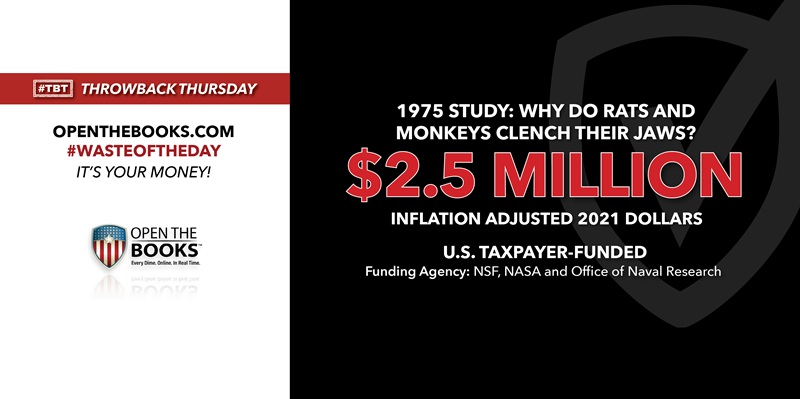
Throwback Thursday!
While they don’t have bills to pay or worldwide pandemics to worry about, even rats and monkeys experience stress.
The National Science Foundation, National Aeronautics and Space Administrationb and the Office of Naval Research spent more than $500,000 — more than $2.5 million in inflation adjusted 2021 dollars — over a decade to determine under what conditions rats, monkeys, and humans bite and clench their jaws.
In 1975, Sen. William Proxmire, a Democrat from Wisconsin, gave the agencies a Golden Fleece award, deeming the funds a waste of taxpayer money.
Proxmire called behavioral scientist Ronald Hutchinson’s work “nonsense” and discussed it in detail on the Senate floor, with his staff, and in a newsletter sent to more than 100,000 of his constituents.
While the newsletter didn’t use Hutchinson's name, it said the “NSF, the Space Agency, and the Office of Naval Research won the 'Golden Fleece' for spending jointly $500,000 to determine why monkeys clench their jaws.”
Hutchinson sued Proxmire for libel, seeking $8 million and arguing that the senator’s statements were false and harmed him. Proxmire argued his statements, press release, and newsletters were protected by the Speech and Debate Clause.
The case made its way to the U.S. Supreme Court, where the justices agreed partly with Hutchinson and partly with Proxmire and sent the case back to the lower court for further proceedings in 1979, when the men settled the matter out of court.
This didn’t deter Proxmire, who continued to present the awards for what he saw as wasteful spending until he retired in 1988.
Ohio State University Pays $12,000 For White Privilege Activist to Lecture
| September 17, 2021
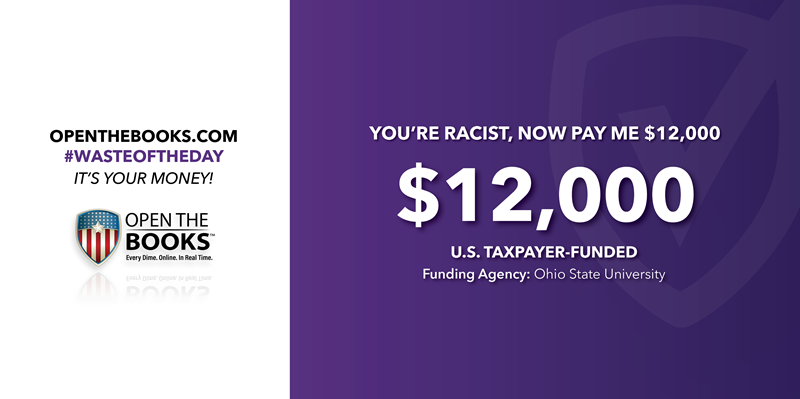
Ohio State University spent $12,000 in March 2021 to show white people how racist they are.
The public university hired Robin DiAngelo, a University of Washington professor known for her focus on racism studies along with her books “White Fragility: Why It's So Hard for White People to Talk About Racism” and “Nice Racism: How Progressive White People Perpetuate Racial Harm.”
She spoke at Ohio State’s 22nd Annual President and Provost’s Diversity Lecture & Cultural Arts Series over Zoom for about an hour and didn’t take questions.
As an “anti-racist” consultant, DiAngelo is a prominent critical race theory expert. While the white privilege author’s website says for white people it’s “necessary for each of us to continually educate ourselves through books, films, discussions, conferences, community groups, workbooks and activism” she wouldn’t take any questions or have discussion in the Ohio State lecture.
“On a topic as charged as racism, opening the floor to the audience allows for very problematic dynamics (e.g. long-winded speeches, convoluted questions, debates),” her speaking contract claims.
She reportedly earns $728,000 annually from speaking fees, charging an average $14,000 per speech, the Daily Mail reported.
$12,000 an hour to hold a one-way lecture with no discussion on how white people are racist. Students paying Ohio State’s hefty tuition and taxpayers subsidizing the university should be outraged.
The #WasteOfTheDay is presented by the forensic auditors at OpenTheBooks.com.